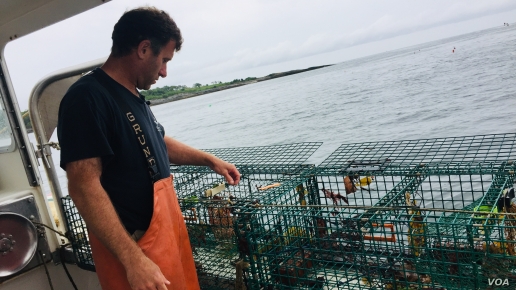
August 7, 2019 PORTLAND, MAINE
Tom Martin has been a lobsterman for 35 years.
He started lobstering as a summer job when he was 14 years old, and then every summer until he went to college. When he dropped out of school after a year, he began lobstering year round.
On this drizzly summer morning, Martin is out on his boat, the Lucky Catch, hauling traps out of Casco Bay off the southern coast of Maine.
He says he enjoys what he does, despite the hard work.
"Every year is different … some years you catch a lot of lobsters, some years you don't. But you just work as hard as you can and let the chips fall where they may."
Food fit for kings
Martin and other lobstermen in the area sell their catch to local wholesalers and restaurants, like Luke's Lobster, a waterfront restaurant in Portland Harbor, which serves about 60 whole lobsters a day.
Working directly with local fishermen means customers get the freshest seafood, at a fairer price to fishermen, says Ben Conniff, the co-founder and chief marketing officer of Luke's Lobster.
Customer Tian-feng GU, a Chinese tourist who studies in Boston, raves about the restaurant's tasty crustacean.
"It's fresh, it's pretty tasty, and the price is really good!" she said.
She acknowledges that the Chinese "love their fresh seafood," especially the succulent shellfish for which Maine is so famous. "We have lobster in Boston, but I definitely like this more!"
Lobster tariffs
But China's love of fresh seafood, particularly live lobsters, has become a challenge for companies like Maine Coast, a live lobster wholesaler headquartered in York, Maine.
In July 2018, Beijing retaliated against U.S. tariffs on Chinese goods by raising their own tariffs on U.S. food and agricultural exports, which included live lobsters.
Vice President of sales and marketing at Maine Coast, Sheila Adams, says she saw the company's business drop by 20% overnight.
"Essentially what's happened is about 80% of our sales into mainland China have gone away," she said. "And that's purely because our product is simply just too expensive compared to the Canadian because of the additional 25% tariff that was levied."
The tariff has to be paid by the Chinese customers.
"The North American lobster is caught in U.S. waters, but also in Canadian waters," Adams said. "So when they make a buying decision between 'Do I want to buy a lobster out of Canada or do I want to buy a lobster out of the United States?' it becomes very difficult for them to make a decision to buy an American lobster because it's so much more expensive.
"The Chinese as a culture love live seafood in general, and have a particular passion for live lobster," she explained. "Obviously it's a very large country, with a lot of people, so they consume — or have the ability to consume — a lot of lobster, which is important for us as a wholesaler volume business."
But with the loss of China as a major customer, Adams and her team have had to look to other markets — both domestically and overseas — to make up the difference.
Diversification is key
Today, as fresh live lobsters arrive at the Maine Coast facility, they are processed, packaged and prepared for shipping to 29 other countries.
"It takes all of those other countries combined to equal one market in mainland China. So we had to put a tremendous amount of effort across many, many markets to try to recoup the lost business in China," Adams said.
But the company has been able to recoup some of those losses.
"We've got a really talented team that we're very thankful for," she added. "And they were able to redirect their efforts, shifting from active engagement in mainland China to taking that skill set and focusing on Asian markets here domestically, and in Canada, and in other places in the world."
Diversification like that is key, says Wade Merritt, president of the Maine International Trade Center, and director of international trade for the state of Maine. He points to Maine Coast as a good example of the dramatic impact of Chinese tariffs on the industry, and a good example of their logical response.
"We were up about 170% from January to June of 2018 — that was prior to the tariffs," he said. "But by the end of the year, Maine's exports of live lobster to China had actually declined by almost 7%. So we gave up a lot of ground in a very short amount of time in those six months."
As for overall exports of live lobster to China from Maine, Merritt said they are down 82% between 2018 and 2019. "So it has had a significant impact on that industry."
Impact that has had a severe trickle-down effect.
"Think about the corner store, or the gas station, or the schools, or the anything in any of these communities that is a major lobster fishing port," Merritt said. "If they're not fishing lobsters, then there is a real problem for those other businesses too. So there are definite ripple effects that cascade down through the economy."
Cause for optimism
In addition to diversification, Merritt encourages companies to continue nurturing existing relationships.
Sheila Adams agrees.
"I think at the end of the day, our relationships with our customers in China are really important to us," she said. "They tell us that they remain optimistic and they look forward to the day when the tariff situation resolves, and that we can go back to doing business together.
"The most important thing is let the free market economy come back to being and let trade happen. And that will make everybody pretty happy."
Lobsterman Tom Martin checks his traps
off Casco Bay on the Southern cost of Maine. (J. Taboh/VOA News)
